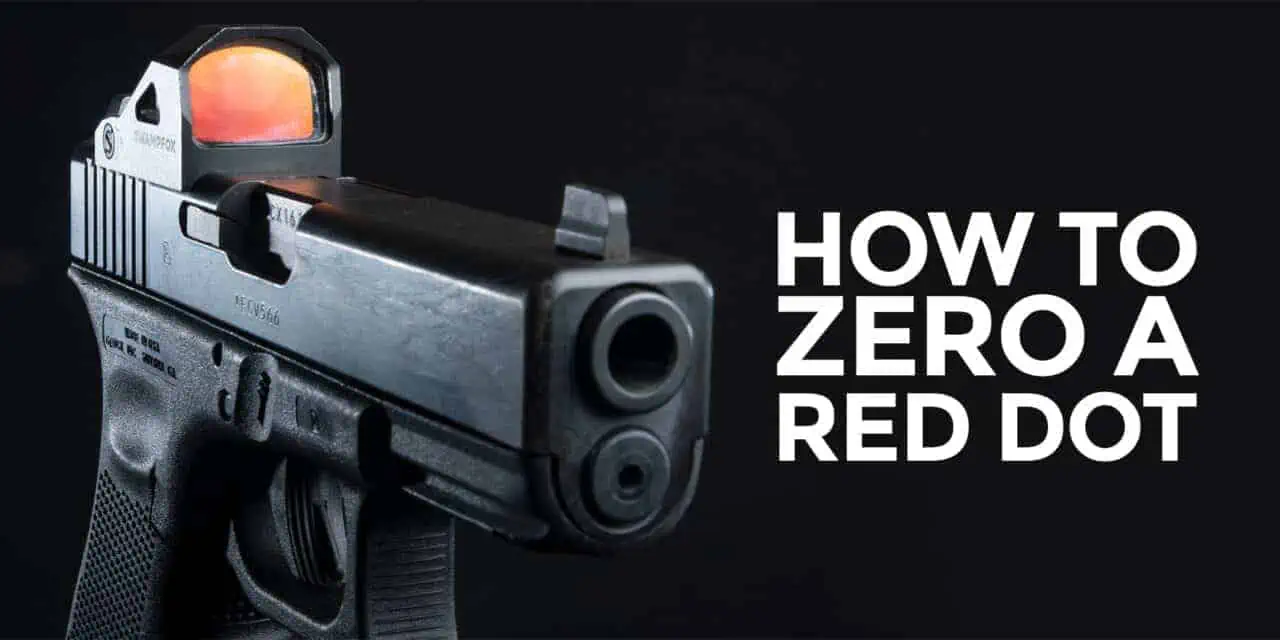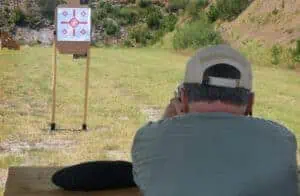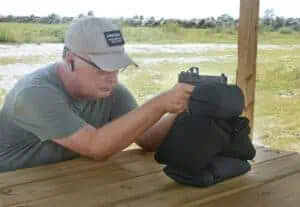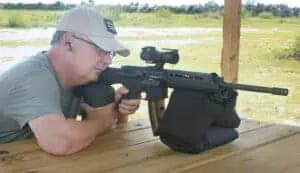Learn How To Zero A Red Dot
The revolution in electronics has affected the firearms world but lightly. Devices that were once in the world of science fiction are now in the palm of our hands. Guns, however, remain more or less the same. Aside from new manufacturing processes and new materials, guns work the same way they have for decades and decades. Miniaturized lasers are now both rugged and inexpensive. This in turn means that small red dot optics are now both rugged and inexpensive, which means they are becoming a popular option for rifles and pistols. Simply mounting a red dot on your gun isn’t enough. You also need to know how to zero a red dot so your shots land in the right place on the target.
Let’s pause for a moment, however, and talk about how a red dot optic works. A red dot optic is essentially just a bright laser (usually red) that projects a dot on a piece of glass. That dot can be moved to coincide with where your shots are landing on the target, and it’s that process of making your dot and your shots meet up that’s at the heart of how to zero a red dot.
Three Reasons To Switch To A Dot
We went into more detail about what a red dot pistol sight does in another article, but to sum up, a red dot on a defensive pistol does three things.
- It allows you to focus on the target, not the front sight
- You can see more of the target in your field of view
- A dot extends the effective range of your defensive pistol
Some of the downsides of a red dot are the cost of the optic and mounting it to the slide, the training needed to use it to its full extent, and finding a holster that works with your gun and attached optic.
When it comes to rifles, a red dot allows you to quickly move from target to target in close range situations and still give you a usable aimpoint at longer distances. A red dot on a rifle also lets you focus on the target and see more of your target, just like on a pistol. These are just some of the reasons why a red dot is a popular choice for the military and law enforcement as well as the armed citizen.
How To Zero A Red Dot On Your Gun Of Choice
Now that we know why you might want a red dot optic on your gun, let’s look at how to zero a red dot and make it a useful part of your gun. The first decision you need to make is what distance you’re going to zero your optic. When we “zero” a gun, we set a distance where the aiming device on our gun and the bullets from that gun are going to wind up in the same spot.
If you draw a line from the optic on your gun to the target and a line from the chamber of your gun to the target and another imaginary line from the chamber to the aiming point in your optic, it will form a very long and skinny triangle. The length of that triangle will grow or shrink as the distance to the target changes. This means that bullets fired from a gun that is zeroed at, say, 25 yards, will land in a different spot when you shoot the gun at 100 yards. This is called “holdover,” and it will vary depending on the ammunition and gun you’re shooting as well as your zero distance.
What’s the Best Distance To Zero Your Gun?
Choosing zero distance depends on what you want from your gun and your optic. For instance, I zero all the optics on my ARs at 100 yards, because I want a consistent holdover when I’m shooting an AR. With my rimfire guns, however, I like a 25 yard zero because of the lower power of the .22 LR round. Pistols, however, require a different zero than a rifle. You’re much less likely to engage targets beyond 50 yards with a pistol, so a 25 yard or even 10 yard zero on a pistol with a red dot is probably best for most shooters.
I recently had to zero the red dot optics on one of my AR’s as well as a pistol, and so I thought I’d walk you through how to zero a red dot on both of those types of guns. The process is actually very similar for both guns.
Start At Zero
Begin by creating a stable firing platform. A good, solid table and chair is your starting point for keeping yourself stable. Your gun needs to be stable as well, so round up some sandbags, shooting bags or something similarly heavy but flexible. The point of all of this is to make sure you and your gun move as little as possible as you shoot each group.
Set your target up at your zero distance. I’m zeroing an AR-15 with a .22 conversion kit, which I’ll zero at 25 yards. The pistol I’m zeroing is the Glock 19 I use as an everyday carry gun, and I’ll zero that gun at 10 yards with some practice ammo, and then confirm the zero with a few rounds of 147 grain Federal HST, my carry ammo of choice.
Keep A Stable Outlook
The process for zeroing a red dot is the same, no matter if you’re shooting a rifle or a pistol. Shoot your first group. Focus on an aiming point on the target, and shoot three rounds. The purpose of this group is to see how far off your sights are from where the bullets are actually landing on your target. There is a decent chance that your bullets didn’t actually hit where you wanted them to hit. They may not have hit the paper at all. Relax, it happens to everyone. Simply move the target closer until the rounds are landing on the paper when you aim at the same aiming point. Make your adjustments at that distance, and then move the target out to your final distance after that to confirm your zero.
Let’s talk for a minute about how to adjust your sight. You want to spin the adjustment knobs on your sight towards the aiming point on your target. The up and down movement of the sight is called the elevation, and the left-right movement is called windage. For instance, if you’re aiming at the center of your target and your shots are landing on the top left portion of the target, you want to move the elevation downwards and the windage to the right to correct for where your shots are landing on the target.
Moving The Dot To Hit Your Mark
How much you should move the dot depends on your sight and the distance to your target. Most red dot sights are ½ MOA per click, and I talk about how that translates into movement on the paper in this article about how to sight in a rifle. The short version of that article is that at 25 yards, a red dot sight with a ½ MOA per click setting will move the impact of your rounds only ⅛ of a inch, so be prepared to spin that knob quite a bit if your shots are landing on the edge of the target.
Red dots are a useful and versatile addition to a wide variety of guns, and knowing how to zero a red dot is an essential part of getting the most from your optic. If your optic isn’t set up properly, a few minutes will help you make sure your shots will land where you need them to land, when you need it the most.





